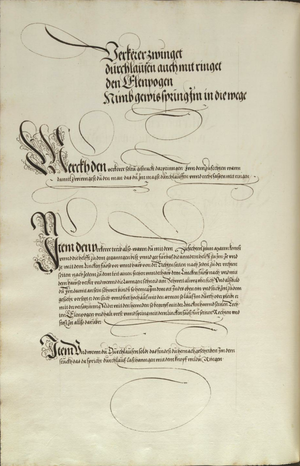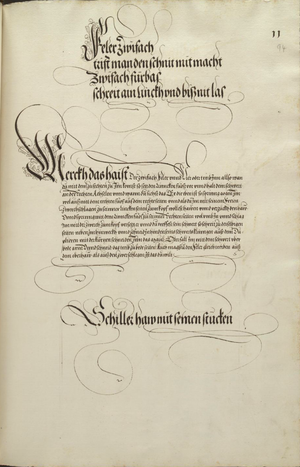|
|
You are not currently logged in. Are you accessing the unsecure (http) portal? Click here to switch to the secure portal. |
User:Kendra Brown/Latin Lew/87r
Munich 87r / PDF page 19
Contents
Missing Zettel verses from Dresden 93v (24)
German
Verkerer zwinget durchlaufen auch mit ringet den Elenpogen Nimb gewis spring Im in die wege
English (Fritz)
Verkehrer forces Durchlaufen and also wrestling. Take the elbow certainly spring into his path/way.
87r a
87r a Latin
CONVERSOREM vel ictum conversum hoc modo exerceas, semper contra hostem sinistrum pedem praefigas, et ex latere dextro, hostis item dextrum ferias, quotiesque sinistro fueris progressus, curabis ut in ipso progressu inferum ictum ferias, verum in ipso ictus exercitio, aciem longam ensis convertas, ut semper ea superior existat, et quamprimum ensem eius contigeris, superne mucronem contra ipsum ingeras, atque eius visum fodias.
Id vero si removerit, nec non brachia sursum levarit, tu transcurrere memineris, at si remanserit, neque brachia sustulerit, tum manu sinistra cubitum eius dextrum corripito, firmiter pro viribus si continueris, prosiliendo sinistrum pedem hostis dextro praeponas, impellasque eum per eundem.
87r a Latin (Sandbox)
- CONVERSOREM vel ictum conversum hoc modo exerceas,
- semper contra hostem sinistrum pedem praefigas,
- et ex latere dextro,
- hostis item dextrum ferias,
- quotiesque sinistro fueris progressus,
- curabis ut in ipso progressu inferum ictum ferias,
- verum in ipso ictus exercitio,
- aciem longam ensis convertas,
- ut semper ea superior existat,
- et quamprimum ensem eius contigeris,
- superne mucronem contra ipsum ingeras,
- atque eius visum fodias.
- Id vero si removerit,
- nec non brachia sursum levarit,
- tu transcurrere memineris,
- at si remanserit,
- neque brachia sustulerit,
- tum manu sinistra cubitum eius dextrum corripito,
- firmiter pro viribus si continueris,
- prosiliendo sinistrum pedem hostis dextro praeponas,
- impellasque eum per eundem.
- Quando autem transcurrendum sit,
- paulo post describetur.
87r a English
Practice the turner-over or inverting strike in this way, always set the left foot in front against the opponent, and from the right side, strike the opponent likewise on the right, and as often as you would advance, take care in order to strike a low strike in the advance itself, truly by practicing the strike according to itself, you invert the long edge of the sword, so that it always appears from above, and you contact his sword to the highest degree possible, you thrust itself in against the higher sword, and dig at his face.
Truly if he shifts it, and also lifts the arm upward, you should remember to run across, or if he stays behind, neither lifting the arm, then seize his right elbow with the left hand, if you have held firmly with strength, having leapt forward, you place with the right in front of the left foot of the enemy, and drive him by the same.
87r a English (Sandbox)
- Practice the turner-over or turning strike in this way,
- always set the left foot in front against the opponent,
- and from the right side,
- strike the opponent likewise on the right,
- and as often as you would advance,
- take care in order to strike a low strike in the advance itself,
- truly by practicing the strike according to itself,
- you reverse/turn over the long edge of the sword,
- so that it always appears from above,
- and you contact his sword to the highest degree possible,
- you thrust itself in against the higher sword,
- and dig at his face.
- truly if he shifts it,
- and also raises the arms upward,
- you should remember to run across,
- or if he stays behind,
- neither lifting the arms,
- then seize his right elbow with the left hand,
- if you have held firmly with strength,
- having leapt forward, you place with the right in front of the left foot of the enemy,
- and drive him by the same.
- When, on the other hand, he is run across,
- as will be described a little later.
87r a notes
- Note: no Latin equivalent for zufechten here
- two phrases for one concept-- near variants of the translated word. no parallel in german.
- No halves at all in the Latin
- Indes in the German, but weird indes (much less opponent action leading up to indes than usual)-- Latin still avoids the term but the clauses don't seem strangely ordered here (as they do other times german has indes). It's almost like the opponent is getting the indes here (choosing one of two paths in response to an attack, and then you have an answer for each of those)
- Are there other times Indes appears in the German and the Latin isn't messed up? (seems like no)
- Are there other times the opponent's actions aren't explicitly mentioned before indes?
Missing Zettel verses from Dresden 94r (25)
German
Feler zwifach trift man den schnit mit macht Zwifach furbas Schreit ain Linckh und biss nit las
English (Fritz)
Fehler twice. When one hits, slice at the same time. Twice further on. Go forward left and don’t be lax.
87r b
87r b Latin
Quando autem transcurrendum sit, paulo post describetur.
DE DUPLICI ICTU ERRAtico.
IS est geminus, qui iam describetur subsequenter, eumque hoc modo exerceas, in congressu mutuo sinistrum pedem praeponas, dextro humero ensem adiungas, et si prospexeris hostem esse tibi exoptatum quem ferias, tum dextro pede prosilias in latus dextrum tuum, teque ea ratione componas, quasi latus capitis adversarij sinistrum transversario libero percussurus, verum ictu retracto, si in latus eius dextrum sinistro pede prosilveris, transversario caput ipsius quassato. at si is impetum eum exceperit, tuque ensem tantum contigeris, paulum iuxta id latus progressus, ex duplationis habitu retro medium hostis ensem acie brevi os proscindas, vel utrunque brachium. Hunc habitum de latere utroque exercere licet, atque aequé ex ictu superno quam transversario erraticum formare potes.
87r b English
It is a twin, which will soon be described subsequently, and practice it in this way: in the mutual approach, place the left foot forward, contact the sword with the right arm/shoulder, and, if you foresee that you would strike an enemy, for whom you have longed, then leap forward with your right foot to your right side, and compose yourself with this method, as if [you were] freely beating the left side of the head of the adversary, truly drawing back the strike. if you leap forward on his right side with the right foot, batter[fut. imp] his head in the running across. And if he sets aside this forward attack, and you contact the sword so much, then advance a little[,] close to that side, then, out of the doubling gesture you should cut [with the edge/forward part of the sword] back to the middle of the sword of the opponent, hit his mouth using the short edge, or the other shoulder. It is permitted to practice this gesture from both sides, and you can shape the wild by transversing equally from the highest strike possible.
87r b Latin (Sandbox)
- DE DUPLICI ICTU ERRAtico.
- IS est geminus,
- qui iam describetur subsequenter,
- eumque hoc modo exerceas,
- in congressu mutuo sinistrum pedem praeponas,
- dextro humero ensem adiungas,
- et si prospexeris hostem esse tibi exoptatum quem ferias,
- tum dextro pede prosilias in latus dextrum tuum,
- teque ea ratione componas,
- quasi latus capitis adversarij sinistrum transversario libero percussurus,
- verum ictu retracto,
- si in latus eius dextrum sinistro pede prosilveris,
- transversario caput ipsius quassato.
- at si is impetum eum exceperit,
- tuque ensem tantum contigeris,
- paulum iuxta id[^1] latus progressus,
- ex duplationis habitu retro medium hostis ensem acie brevi os proscindas,
- vel utrunque brachium.
- Hunc habitum de latere utroque exercere licet,
- atque aequé ex ictu superno quam transversario erraticum formare potes.
87r b English (Sandbox)
- Regarding the twofold wild strike.
- It is a twin,
- which will soon be described subsequently,
- and practice it in this way:
- in the mutual approach, place the left foot forward,
- contact the sword with the right arm/shoulder,
- and, if you foresee that you would strike an enemy, for whom you have longed,
- then leap forward with your right foot to your right side,
- and compose yourself with this method,
- as if [you were] freely beating the left side of the head of the adversary,
- truly drawing back the strike.
- if you leap forward on his right side with the right foot,
- you batter his head in the running across.
- And if he sets aside this forward attack,
- and you contact the sword so much,
- then advance a little[,] close to that side,
- then, out of the doubling gesture you should cut [with the edge/forward part of the sword] back to the middle of the sword of the opponent, using the short edge,
- and even the other shoulder.
- It is permitted to practice this gesture on both sides,
- and you can shape the wild by transversing equally from the highest strike possible.
87r b notes
parallel phrase (multiple targets), present in German but with different grammar and details
[^1]: could this "id" refer to "indes"?


